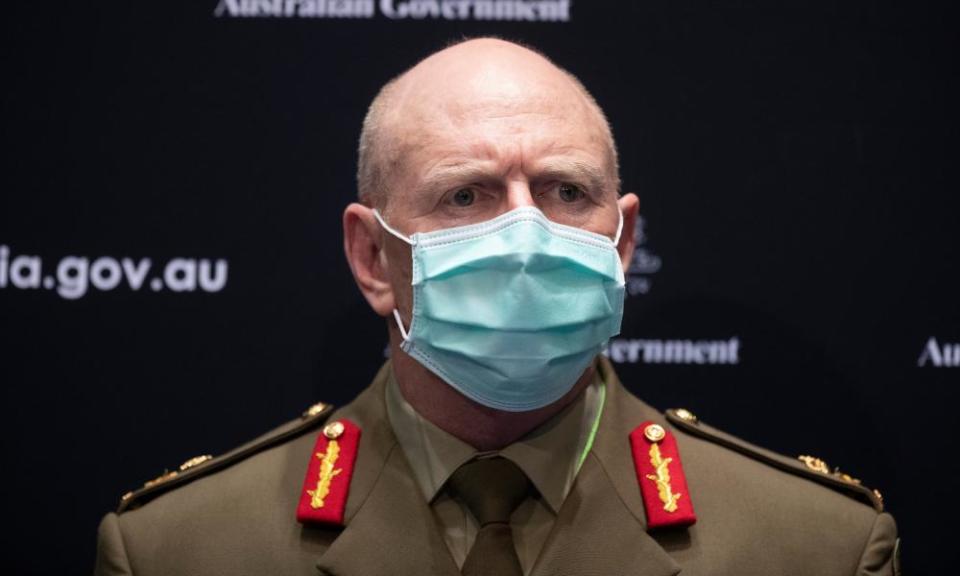Updated national plan suggests 80% of Australians could be fully vaccinated by end of 2021

Australia could fully vaccinate 80% of its adult population by December under a “vision” outlined by Operation Covid Shield, with the federal government calling for an unprecedented level of collaboration across the country to accelerate the rollout.
An update to the national vaccine campaign program being spearheaded by Lt Gen John Frewen, released on Tuesday, states that 80% of the eligible population could “potentially” have received both doses of a vaccine by December, with a 70% vaccination rate achieved by November.
The federal government has previously suggested that once 80% of those aged 16 and over are vaccinated Australia can move to a “consolidation” phase of the national pandemic exit plan that was endorsed by national cabinet on Friday.
That third phase would exempt vaccinated residents from domestic restrictions, remove caps on returning vaccinated Australians and lift restrictions on outbound travel. Leaders would only ever pursue “highly targeted lockdowns”.
Related: National pandemic exit plan modelling doesn’t examine what happens after restrictions are eased
Tuesday’s updated Operation Covid Shield document flags a rapid increase in the delivery and distribution of vaccines with drive-through vaccination clinics operating “at scale in most jurisdictions” by mid-October. Workplace vaccination and retail hubs would also be operating by the end of the year with pilot programs to begin by October.
The plan flags that school vaccination programs could be underway by early December “pending decision about whether to open school programs”.
“This plan flags not only the requirement to accelerate the nation’s vaccine rollout, but also highlights the need for an unprecedented level of collaboration across boundaries, using all available resources of governments at every level, industry partners and our diverse communities to ensure our collective health and prosperity,” the document states.
It says this “vision will have been realised” when the vaccination targets set out in the national transition plan have been achieved.
Under the plan, Australians over the age of 30 will be offered vaccines from September when 10m doses of AstraZeneca, Pfizer and Moderna could be available, with those aged 16 and over included from October when the available supply jumps to 15m doses for the month with increasing availability of Pfizer.
But the document also says contingencies are needed around these “indicative” timeframes given “unplanned events could impact rollout targets, whether related to sentiment, supply or distribution”.
According to a revised schedule, the number of doses available peaks in November, with almost 19m doses on offer, according to the plan, comprising 10m Pfizer, 5m AstraZeneca and 4m Moderna.
The plan proposes three key elements of the strategy, “coordinate”, “motivate” and “deliver”, which includes a push to “shape positive public sentiment and drive public action via targeted communications and incentives”.
It says positive public sentiment is the “centre of gravity” for the plan, with the concept described as “the primary entity that possesses the inherent capability to achieve the desired end state”.
“This principle is maximised when there is high motivation for the public to get vaccinated and when the public perceives the rollout to be an effective and well-coordinated program and is supported by taking a user centred approach,” the documents states.
“It can be measured directly, for example through intention to get vaccinated and public trust and confidence in the program.”
It states that to build trust and confidence in the plan among the public and relevant stakeholders “there will be a strong bias by the commonwealth to transparency” that will apply to all non-sensitive rollout metrics.
Related: General confusion: who is John Frewen, and what is his role in Australia’s vaccine rollout?
“This will ensure progress is visible to the public and obstacles are quickly identified and addressed.”
The document flags the potential use of financial incentives to boost the vaccination rate. This comes after the government derided Labor’s $300 cash for jabs proposal as an “insult” to Australians.
“While studies have shown financial incentives are unlikely to drive whole-scale vaccine uptake, the NCVTF [vaccine taskforce] will continue to work with jurisdictions and industry in looking at the role financial incentives have to play in targeting cohorts of people,” the program states.
“This may include considering the role of gift vouchers and prize-drawers led by industry and business.”
The Coalition’s vaccine rollout has been plagued by problems with an initial pledge to have Australia fully vaccinated by October long abandoned. So far 18% of the adult population has received two doses of a vaccine.
Questions have also been raised previously about the commonwealth’s vaccination forecasts.

 Yahoo Finance
Yahoo Finance 